What is Swiss chard, how to eat it correctly and how it can be useful
The German name mangold was stuck behind it, although it was known both as "Roman cabbage", and as "Jerusalem artichoke", and as "grass stem". An inexperienced person is unlikely to distinguish its tops from beet tops, but the differences are still significant. We will tell you what it is - Swiss chard, what are its benefits and harms, how it is grown and eaten.
The content of the article
What is Swiss chard
At first glance, it looks like spinach. Indeed, there are family ties: both of them are from the amaranth family, but these are distant relatives. In fact, the vegetable is directly related to the leaf beet and is a subspecies of it.
Appearance
If sweet and healthy roots are valued in beets, then chard does not have them, and leaves and stems, which form high rosettes, are used for food.... The plant is biennial, and in the first year its rosette is not so lush. But the next, she amazes with her curliness.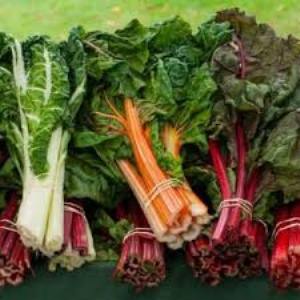
The leaves are usually large - up to 30 cm, heart-shaped or elongated, with a smooth or pimpled surface and wavy edges. Depending on the variety, they come in different colors and shades: dark or emerald green, yellow, purple, red, pink. The veins on the leaves contrast with the background, for example, red, yellow, or silvery veins can be seen on a green leaf.
The petioles are juicy, fleshy, up to 25 cm high, up to 5 cm thick. Their color is also colorful: white-milk, light green, yellow, orange, burgundy (the photo shows a rich spectrum of colors). The stems can grow up to 2 m. The flowers of the plant are inconspicuous, small, collected in leafy inflorescences.
Summer residents often decorate their plots with this vegetable: by properly planting varieties, you can achieve a shade transition of color and thus decorate the backyard territory.
Composition and useful properties
The vegetable contains a lot of vitamins, amino acids, minerals. It is especially enriched with vitamin K: 100 g of the product contains 830 mcg, while the daily norm of an adult is 90 mcg. This vitamin is involved in protein synthesis, and affects kidney health and metabolism.
Important! People who are prescribed anticoagulants are advised to be selective about foods high in vitamin K, as it affects blood coagulation.
Vitamin A also accounts for a significant proportion: 306 mcg, or 34% of the daily value.
Key minerals:
- potassium - 379 mg (15% of the DV);
- magnesium - 81 mg (20% of the DV);
- iron - 1.2 mg (10% of the daily value);
- manganese - 0.37 mg (19% of the DV).
B vitamins:
- thiamine - 0.04 mg (3% of the daily value);
- riboflavin - 0.09 mg (5% DV);
- pantothenic acid - 0.17 mg (3% DV);
- pyridoxine - 0.1 mg (5% DV);
- folate (B9) 14 mcg (4% DV)
This product is classified as low-calorie (19 kcal).
In 100 g of chard:
- proteins - 1.8 g;
- carbohydrates - 3.74 g;
- fat - 0.3 g;
- water - 92.66 g.
The vegetable cleanses the blood and improves its clotting, reduces blood pressure, has a beneficial effect on the cardiovascular system, prevents osteoporosis and sclerosis, strengthens the immune system. It is recommended for anemia and diabetes mellitus.
Contraindications
Chard can harm people suffering from high blood viscosity, varicose veins or thrombophlebitis, as the vegetable thickens the blood.Patients with stones in the kidney or gallbladder should also exclude it from the diet, since the oxalic acid salts (oxalates) present in it crystallize, clogging the renal ducts.
Because of oxalates, people with gout and rheumatoid arthritis need to be careful when using Swiss chard.
Popular varieties
Chard is presented in two forms: leaf and stem.
Leaf (or chives chard) is characterized by rapid growth of leaves after cutting. Its stems are delicate and thin. Such a vegetable ripens in a month and a half after germination. Popular leafy chard varieties include Spinach, Leafy Green, and Winter. They are frost-resistant, have a lush but short leaf rosette.
Stem (petiolate) type has powerful "sinewy" petioles. This type of chard is ready to eat three months after germination. Stem varieties include Rubin, Buls Blood, Scarlet, Garnet, Volcano. Their stems are bright red, crimson and even purple. There are petiolar varieties with white and green stems: Emerald, Malachite, Mirage, Swiss.
Read also:
Why is it worth growing an early ripe and disease-resistant tomato "Moskvich".
Early ripe yellow melon "Fairy Tale f1".
The best varieties of zucchini for open ground: a photo with a description, tips for choosing.
Growing and care
The vegetable is unpretentious to care for, but there are still some rules for its cultivation.
In the open field
Sowing in open ground is done in three stages. This allows you to provide the table with healthy herbs from mid-summer until the first frost.
The first stage is spring... The exact pick up time varies by region. If the conditions are favorable, then sowing seeds in open ground is permissible already in mid-April, after soaking them. If the ground is still frozen, then it is better to wait until May and sow dry seeds.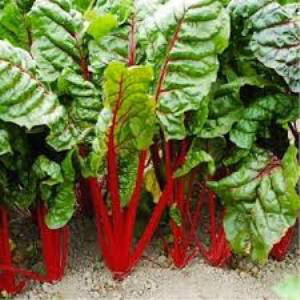
The second stage is summer. To get a rich harvest by the beginning of winter, it is necessary to sow soaked seeds in July. They are sown in place after already harvested onions, potatoes or strawberries, but not after beets and not next to spinach.
The third stage is late autumn. Dry seeds are sown in October-November. The crop from this crop grows the next spring.
The soil for planting chard must be fertile. To do this, you need 1 sq. m of soil, add up to 5 kg of humus, saltpeter, superphosphate, potassium sulfate - each fertilizer 20 g.
Chard requires regular watering, and occasionally top dressing. Since the leaves and petioles are capable of accumulating nitrates in themselves, it is better not to feed it with nitrogen fertilizers. Many gardeners admit that they do not feed Swiss chard at all, while it grows well. The crop is removed after 40-70 days after germination. One plant gives up to 1 kg of yield per year.
Plants planted in May are harvested in September. They are well dried and stored until next spring for sowing. If the winters are harsh in the region, then in late autumn it is better to dig up a plant with roots, place it in boxes with soil and send it to a cellar or greenhouse for growing.
In the greenhouse
To arrange a plant for wintering in a greenhouse, it is necessary to prepare containers where it will be located. Suitable containers (these can be boxes) need to be treated with a solution of potassium permanganate, think over drainage, pour sand. The soil for planting must be fertilized with organic matter.
For forcing greens, the rhizomes of healthy plants are suitable, which are placed close to each other (bridge planting method), sprinkled with soil. A week of rhizomes must be kept in the dark. Watering with water at room temperature, but without fanaticism: too much watering can lead to root rot.
When planting, the temperature in the greenhouse should be 9-11 degrees, when the first shoots appear, it must be increased to 14-18 and maintained at this level. During the winter months, feeding should be regular, once a month.
After 20-25 days, you can harvest a green crop.
On the windowsill
If you don't have a summer cottage, and in the nearest supermarket you haven't heard of such a vegetable, it doesn't matter. Since the plant does not need special care, it will grow well in a city apartment. This will require wide window sills, flower pots or neat boxes, soil, and plant seeds.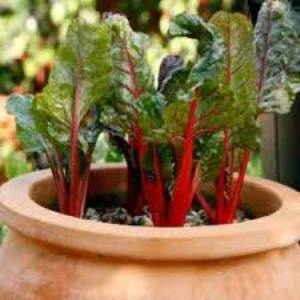
Chard in the apartment also performs a decorative function. If you approach its cultivation with imagination, then you can achieve an excellent effect by combining the colors of the leaves and petioles with each other. To do this, use different plant varieties, for example, White Silver and Lucullus, or purchase the Rainbow variety. The best time to plant is mid-February.
The requirements for the soil are to prepare a mixture of humus and sod land in equal proportions with the addition of half of river sand. You also need to take care of drainage.
Seeds must be sown in warm, moist soil to a depth of 2-2.5 cm. Water with cold, settled water regularly, but not abundantly, every two days, and if the apartment is hot and dry, then every other day. In an unheated apartment, the seed pots must be tightly covered with foil. Once a month, feed with an infusion of eggshells or wood ash.
The optimum temperature for the growth of chard is 14-18 degrees.
Chard application
Chard leaves and stems are useful in any season, and for this you need to know what you can cook from it and take care of how to preserve the vegetable.
In cooking
Mangold is eaten raw, boiled, fried, stewed and baked. It goes well with other ingredients, it successfully replaces cabbage in borscht and cabbage rolls, can be used instead of grape leaves in dolma, is suitable for vegetable and meat casseroles.
We present you several recipes for Swiss chard dishes.
Provencal omelet
Ingredients: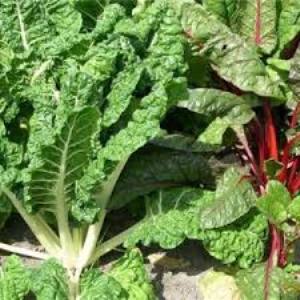
- 200 g of Swiss chard leaves;
- 4 tbsp. l. olive oil;
- a mixture of provencal herbs;
- 1 onion;
- 5 eggs;
- 2 tbsp. l. milk;
- salt and black pepper to taste;
- 1 sprig of parsley.
Preparation:
- Blanch the chard leaves in hot water for two minutes. Then drain the water, rinse with cold water, chop finely.
- Cut the onion into thin half rings, fry in a pan with butter.
- Squeeze the chard leaves, add to the onion and simmer until soft.
- Shake eggs with milk, season with salt, pepper, add Provencal herbs and pour into the pan.
- After a minute, turn the omelet over and fry on the other side.
Dolma from Swiss chard
Ingredients:
- 8 chard leaves,
- for the filling: 250 g minced meat, a quarter cup of rice, 1 egg;
- for frying: half an onion, 2 tomatoes, 1 bell pepper, 1 carrot, 1 clove of garlic, vegetable oil;
- salt, pepper, spices to taste.
Preparation:
- Rinse and boil the rice.
- Finely chop vegetables for frying, fry in oil.
- Add rice, fried and egg to the minced meat, mix, season with salt and pepper.
- Rinse chard leaves, dry, slightly beat off thick petioles.
- Put the filling on each sheet (its amount depends on the size of the sheet), roll the leaves into a roll, bending the side edges, place them in the bowl of the double boiler.
- Steam for 30 minutes. Serve with sour cream sauce or yoghurt.
Vegetable salad
Ingredients:
- 3-4 chard leaves with petioles;
- 2 juicy tomatoes;
- 1 bell pepper;
- fresh dill and parsley;
- 3 tbsp. l. olive oil.
Preparation:
- Finely chop the leaves.
- Cut the petioles into 1 cm cubes, fry in a pan with oil, add a couple of tablespoons of water and simmer until the water softens and evaporates.
- Cut the tomatoes into cubes, pepper into half rings, mix with the cooled petioles.
- Sprinkle the salad with chopped leaves and dill and parsley.
Freezing
In preparations for the winter, it is important to preserve all the beneficial properties of the plant. Therefore, the most effective method is freezing. There are two ways:
- Leaves and stems must be washed and dried. Cut into pieces coarsely, finely or medium-sized, put into bags in portions and place in the freezer.
- Rinse the leaves and petioles, cook in water for two minutes, remove and transfer to a colander to completely drain the water. Cut the cooled greens, as in the first method, divide in portions into packages and leave in the freezer. If necessary, take out a portion and, without defrosting, cook, that is, put it directly into the pan or soup.
If you want to cook dolma or cabbage rolls in winter, then the washed leaves must be dried and frozen whole.
Marinades and preservation
To marinate chard leaves for winter cabbage rolls, you need to rinse them by rolling them up, put them in sterile jars and pour marinade (water, salt, sugar, vinegar, seasonings).
Fleshy stalks are canned separately: rinse, cut, put in jars, pour marinade over.
An assortment of finely chopped leaves and petioles is one option for canning. Such homemade products are added to salads, soups and side dishes.
Medicinal use
Chard is healthy, like any vegetable. Its healing effect is as follows: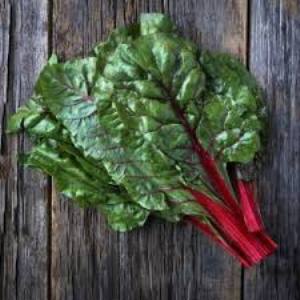
- thanks to calcium, magnesium and vitamin K, it has a beneficial effect on the condition of teeth and bones;
- prevents anemia;
- improves blood quality;
- normalizes blood sugar levels thanks to fiber and lilac acid;
- promotes the activation of brain cells due to the presence of B vitamins;
- preserves vision - it contains lutein and zeaxanthin;
- strengthens the blood vessels of the heart, since it contains kaempferol;
- has an anti-inflammatory effect.
Folk remedies
In case of abscesses and burns, you need to boil the Swiss chard leaves and apply to the problem area, after cooling.
With inflammation and redness of the eyes, crush fresh leaves and make compresses on the eyes.
You can try to remove warts with juice obtained from the leaves and stems of the vegetable.
Attention! You can not use freshly squeezed chard juice due to the increased concentration of volatile substances in it. You need to let it settle and only then drink.
It also fights baldness: the roots are burned, honey is added to the resulting ash and rubbed into the scalp.
For skin rejuvenation, masks are prepared from slightly boiled and crushed stems and leaves.
Conclusion
Mangold is a wonderful green vegetable that has not yet managed to conquer all regions of our vast country. Few have heard of him, even fewer are those who regularly eat it, but fame goes before him.
A little time will pass, and not a single housewife will present her kitchen without this useful helper, saturated with vitamins and minerals, not a single summer resident will miss the opportunity to decorate his plot with lush multi-colored rosettes, and the townspeople will grow rainbow chard greens in their apartments!